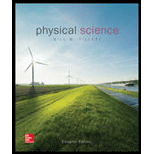
Concept explainers
A referent system that can be used to locate objects in the sky is the
a. celestial globe.
b. celestial coordinates.
c. celestial sphere.
d. celestial maps.
The referent system that can be used to locate the objects in the sky from the following options:
Celestial globe
Celestial coordinates
Celestial sphere
Celestial maps
Answer to Problem 1AC
Solution:
Option (c) is correct.
Explanation of Solution
Introduction:
Referent system is a system for reference that can be needed in order to locate anything, including astronomical objects or planets, in the skyappropriately. It can be established easily by first considering the sky to be an imaginary ‘celestial sphere’.
Explanation:
Reason for the correct option:
The imaginary sphere of arbitrarily larger radius, with earth located at its center is usually referred as theCelestial sphere. In astronomy, all the objects located in the observer’s sky are assumed as projected upon the inner surface of the celestial sphere. To locate the objects in the sky, an imaginary celestial sphere is thus considered as the referent system.
Hence, option (c) is correct.
Reason for the incorrect option:
Option (a) is incorrect because the celestial globe is basically referred as the representation of constellations and stars as they are located on an apparent sphere in the sky. These globes are used for some astrological or astronomical calculations, and as ornaments. So, it is a wrong answer.
Option (b) is incorrect because celestial coordinates are the set of numbers that are used for reference in order to pinpoint the position of a celestial object in the sky. In astronomy, several different coordinate systems are used to locate the position of an object in the celestial sphere in the sky. So, it is a wrong answer.
Option (d) is incorrect because celestial maps are the representations of astronomical objects located in the sky. The division of grids makes it easier for the astronomers to develop and use the celestial maps in an appropriate manner. Thus, it cannot be used as a referent system. So, it is a wrong answer.
Hence, options (a), (b) and (d) are incorrect.
Conclusion:
The referent system that can be used to locate the objects in the sky is the celestial sphere.
Want to see more full solutions like this?
Chapter 14 Solutions
Physical Science
- A capacitor with a capacitance of C = 5.95×10−5 F is charged by connecting it to a 12.5 −V battery. The capacitor is then disconnected from the battery and connected across an inductor with an inductance of L = 1.55 H . At the time 2.35×10−2 s after the connection to the inductor is made, what is the current in the inductor? At that time, how much electrical energy is stored in the inductor?arrow_forwardCan someone help me with this question. Thanks.arrow_forwardCan someone help me with this question. Thanks.arrow_forward
 An Introduction to Physical SciencePhysicsISBN:9781305079137Author:James Shipman, Jerry D. Wilson, Charles A. Higgins, Omar TorresPublisher:Cengage Learning
An Introduction to Physical SciencePhysicsISBN:9781305079137Author:James Shipman, Jerry D. Wilson, Charles A. Higgins, Omar TorresPublisher:Cengage Learning Horizons: Exploring the Universe (MindTap Course ...PhysicsISBN:9781305960961Author:Michael A. Seeds, Dana BackmanPublisher:Cengage Learning
Horizons: Exploring the Universe (MindTap Course ...PhysicsISBN:9781305960961Author:Michael A. Seeds, Dana BackmanPublisher:Cengage Learning AstronomyPhysicsISBN:9781938168284Author:Andrew Fraknoi; David Morrison; Sidney C. WolffPublisher:OpenStax
AstronomyPhysicsISBN:9781938168284Author:Andrew Fraknoi; David Morrison; Sidney C. WolffPublisher:OpenStax
 Stars and GalaxiesPhysicsISBN:9781305120785Author:Michael A. Seeds, Dana BackmanPublisher:Cengage Learning
Stars and GalaxiesPhysicsISBN:9781305120785Author:Michael A. Seeds, Dana BackmanPublisher:Cengage Learning Foundations of Astronomy (MindTap Course List)PhysicsISBN:9781337399920Author:Michael A. Seeds, Dana BackmanPublisher:Cengage Learning
Foundations of Astronomy (MindTap Course List)PhysicsISBN:9781337399920Author:Michael A. Seeds, Dana BackmanPublisher:Cengage Learning





